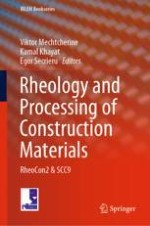2020 | OriginalPaper | Chapter
A Plasticity Theory Approach for the Stability Analysis of Vertical Layers of Concrete in the Fresh State
Authors : Giacomo Torelli, Janet M. Lees
Published in: Rheology and Processing of Construction Materials
Publisher: Springer International Publishing
Activate our intelligent search to find suitable subject content or patents.
Select sections of text to find matching patents with Artificial Intelligence. powered by
Select sections of text to find additional relevant content using AI-assisted search. powered by
